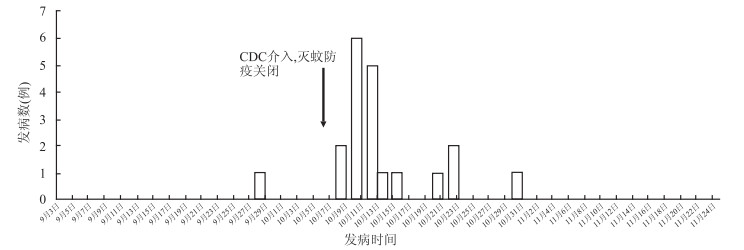Comparison on local dengue fever outbreaks in public place in Shenzhen and Hong Kong in 2018
-
摘要:
目的 对比分析深圳和香港地区两起公共场所登革热疫情流行特征和处置措施,融合优势以更好应对登革热暴发。 方法 收集两地登革热病例信息和蚊媒监测数据进行描述性流行病学分析,并对防蚊灭蚊措施进行对比。 结果 香港地区报告病例19例,疫情持续13 d,分布6个区,男女性别比为1:0.9。深圳20例,持续33 d,分布3个街道,男女性别比为1:0.82。两地年龄差别有统计学意义(Z=-2.855,P=0.004)。香港地区病例从出现症状到实验室确认时间间隔5.5~8.5 d,中位数7 d;深圳为1.5~5.4 d,中位数为2 d,差异有统计学意义(Z=-3.818,P < 0.001)。香港地区疫情第4 d宣布封闭感染场所30 d,灭蚊范围500 m,采用诱蚊诱卵器指数评价灭蚊效果。深圳第2 d宣布"封闭",灭蚊范围400 m,每3 d用布雷图指数、双层叠帐法监测。 结论 两地登革热疫情性质、规模、时间、场所相似,深圳处理措施更灵敏、快速,传染源早发现能力强,蚊媒监测方法更全面、频率更高。香港地区疫情信息公布、媒体风险沟通更主动,灭蚊措施更严格、专业。 Abstract:Objective To compare epidemiology characteristics and control measures of dengue fever (DF) outbreaks in public places in Shenzhen and Hong Kong and integrate the advantages for better response to DF outbreaks. Methods Data of DF cases and mosquito vector surveillance in Shenzhen and Hong Kong were collected for descriptive epidemiological analysis and measures of mosquito control were compared. Results A total of 19DF cases were recorded in 13 d among six districts of Hong Kong, the male: female ratio was 1:0.9. In Shenzhen, 20 cases were recorded in 33 d, the cases were distributed in three sub-districts, the Male: female ratio was 1:0.82; Age difference between Shenzhen and Hong Kong was statistically significant (Z=-2.855, P=0.004). The time interval between date of onset and laboratory confirmation ranging from 5.5 to 8.5 d (median: 7d) in Hong Kong, and ranged from 1.5 to 5.4 d (median: 2 d) in Shenzhen, the difference was statistically significant (Z=-3.818, P < 0.001). On the 4th day of the outbreak, Hong Kong declared 30 d closure for anti-mosquito operations with a range of 500 m, and monthly area ovitrap index (AOI) was used to monitor the territory-wide situation of Aedes albopictus. On the 2nd day of the outbreak, Shenzhen declared source closure for mosquito control with a range of 400 m and emergency vector surveillance was conducted, using Breteau Index (BI) and Human-baited double net trap(HDN) every 3 d. Conclusions The nature, scale, time and place of the two local DF outbreaks in Shenzhen and Hong Kong are similar. The prevention and control system is more sensitive and prompt, the ability of early detection is stronger, mosquito vector surveillance program is more comprehensive and the frequency is higher in Shenzhen. The epidemic information dissemination and risk communication with media is more active, mosquito management and control is more professional in Hong Kong. -
Key words:
- Dengue fever /
- Outbreak /
- Public place /
- Epidemiology
-
表 1 2018年深圳、香港地区两地登革热疫情防蚊、灭蚊措施对比
Table 1. Anti-mosquito operation on DF outbreaks in Shenzhen and Hong Kong in 2018
分组 香港 深圳 灭蚊措施 划定疫点数 22个 13个 防蚊灭蚊范围 500 m 400 m(核心区200 m,警戒区200 m) 宣布封闭 疫情第4 d 疫情第2 d 封闭时间 30 d 连续两次蚊密度监测降至安全值 蚊媒监测 监测频率 日常监测,每月 应急监测,每3 d 监测方法 分区诱蚊诱卵器指数 布雷图指数、双层叠帐法 监测结果 7月,AOI 21.8% 第1 d,BI 42,叮咬指数10只/人·小时 8月,AOI 7.0% 第2 d,BI 6,叮咬指数2只/人·小时 9月,AOI 11.1% 第5 d,BI 4,叮咬指数0 10月,AOI 2.3% 第11 d,BI 2,叮咬指数0 -
[1] 熊劲光, 黄振宇, 陈平华, 等. 一起登革热和一起基孔肯雅热暴发疫情的对比分析[J]. 中华疾病控制杂志, 2012, 16(4): 328-331. http://zhjbkz.ahmu.edu.cn/article/id/JBKZ201204016Xiong JG, Huang ZY, Chen PH, et al. A comparing analysis between dengue fever outbreak and chikungunya fever outbreak[J]. Chin J Dis Control Prev, 2012, 16(4): 328-331. http://zhjbkz.ahmu.edu.cn/article/id/JBKZ201204016 [2] 高淑萍, 肖新才, 景钦隆, 等. 广州市某建筑工地一起登革热暴发的流行病学调查[J]. 中国热带医学, 2017, 17(4): 372-374. DOI: 10.13604/j.cnki.46-1064/r.2017.04.12.Gao SP, Xiao XC, Jing QL, et al. The epidemiological investigation and analysis of dengue fever outbreak in a construction site in Guangzhou[J]. Chin Toop Med, 2017, 17(4): 372-374. DOI: 10.13604/j.cnki.46-1064/r.2017.04.12. [3] 罗雷, 王玉林, 狄飚, 等. 浅析穗港两地登革热预防与控制体系之异同[J]. 现代预防医学, 2011, 38(15): 3065-3066, 3069. https://www.cnki.com.cn/Article/CJFDTOTAL-XDYF201115070.htmLuo L, Wang YL, Di B, et al. Analysis on the difference of control and prevention for dengue fever between Guangzhou and Xianggang[J]. Modern Prevent Med, 2011, 38(15): 3065-3066, 3069. https://www.cnki.com.cn/Article/CJFDTOTAL-XDYF201115070.htm [4] Wang C, Yang W, Fan J, et al. Spatial and temporal patterns of dengue in Guangdong province of China[J]. Asia Pac J Public Health, 2015, 27(2): 844-853. DOI: 10.1177/1010539513477681. -





 下载:
下载:



